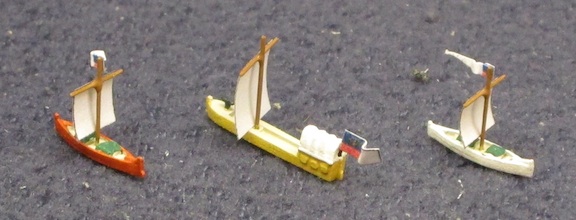Lewis & Clark Expedition

1804
(Johann Wolkersdorfer JWS-4)
- Class: Keelboat (& Pirogues)
- Displacement: 12 tons
- Dimensions: 55 x 8 x 3 ft
- Armament: 1 swivel gun and 2 blunderbusses
- Complement: 1 captain as commander, 1 sergeant as helmsman, 1 sergeant as centerman, 1 sergeant and private as bowsmen, 22 privates as oarmen
- Designer: Meriwether Lewis
- Built: Jacob Myers, Pittsburgh, Pennsylvania, 1803
- Notes: Lewis & Clark's keelboat was built as a galley in Pittsburgh in 1803 for the Lewis and Clark Expedition, following detailed specifications by Meriwether Lewis. It could be propelled by oars, sails, poles and towlines. The boat was the expedition's main vessel until the spring of 1805, when it was returned to St. Louis. Lewis ordered it in May 1803, but it was not ready until late Aug. Lewis sailed it down the Ohio, meeting Clark along the way. They departed Clarksville, Indiana, 26 Oct, arriving at Fort Kaskaskia, 50 miles south of St.Louis, on 28 Nov. They wintered at Camp Dubois on the Illinois side of the Mississippi, across from the Missouri River's outlet.
The Corps of Discovery broke camp 14 May 1804 and headed up the Missouri, with the strong current keeping speed to about one mile per hour. After 1,500 miles they reached the Mandan villages in present-day North Dakota on 26 Oct. The expedition built and wintered at Fort Mandan. The keelboat was sent back to St. Louis with a returning party on 6 Apr 1805. The journey downstream took 43 days, and the boat reached its goal with diaries and scientific specimens. The boat was then probably auctioned off.
The two pirogues which accompanied the keelboat on the expedition were probably large rowboats or bateaux with sails. The main purpose of the red pirogue which sailed from Pittsburgh was to carry supplies to reduce the keelboat's draft to help navigate down the late-summer Ohio. This red or "French" pirogue, which was probably about 41 x 9 feet with a 9-ton capacity, was later manned by nine French Canadians hired at St. Charles to assist the Corps as far as the Mandan villages. The white pirogue, which was probably about 39 x 8 feet with an 8-ton capacity, joined up at Fort Kaskaskia and was known as the "Soldiers" boat, being crewed by a corporal and five privates.
Continuing the ascent of the Missouri in the spring of 1805, the expedition stopped at the mouth of the Marias River 10 Jun and decided to cache the red pirogue. The white pirogue continued as flagship up to the Falls of the Missouri in present-day Montana. On the return journey down the Missouri in 1806, the white pirogue was again the flagship (now leading a number of canoes). However, the cached red pirogue, which was reached on 28 Jul 1806, was so deteriorated it was abandoned. The expedition returned to St.Charles on 23 Sep 1806.



 Up
Up





 Up
Up